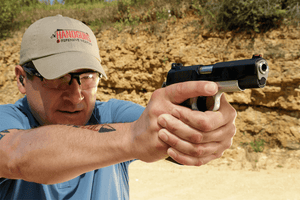Introduction
There was a time when long-range shooting was reserved for rifles. With longer barrels, stocks, and advanced scopes, it always made sense. But as technology evolved, long-range shooting has made its way into the handgun world.
Long-range shooting with handguns is a result of pushing the boundaries in shooting sports. Innovations in optics, compensators, and ammunition have made it easier for shooters to engage distant targets with greater precision.
Why practice long-range shooting with a pistol? Well, it’s the next step in precision shooting. As your accuracy improves, it’s only natural to push your targets farther out.
More than just a trend or something exclusive for hunters, long-range shooting has gained serious popularity. Competitions like the International Handgun Metallic Silhouette Association and NRA Silhouette Shooting bring new challenges, and they’re not just fun—they push you to keep honing your skills.
If you're ready to elevate your precision shooting, you’ve hit the bullseye. This guide covers all the tips, shooting positions, techniques, and gear you need to master long-range shooting with your handgun.
Understanding the Basics of Long-Range Shooting
Let’s start with what is considered long-range shooting. As a standard, anything beyond 300 yards is long-range territory. This is based on rifle shooting, with some competitions going for over a mile.
Now, in handgun competitions, “long-range” typically means distances between 100 and 200 yards, though you might stretch that up to 300 yards for an extra challenge.
If you have read our marksmanship tips guide, then you already know that stance and breathing control are fundamental to progressing as a shooter. That’s why practicing long-range shooting with a handgun is so important: it means that you’ve moved beyond the beginner stage.
So now, let’s talk about ballistics and some key concepts of long-range shooting:
MOA (Minute of Angle)
MOA is a unit of measurement that tells you how much your point of impact shifts. When shooting at long distances, even a small adjustment can mean the difference between a bullseye and a complete miss.
As a standard, for every 1 MOA adjustment, your shot moves about 1 inch at 100 yards. At 200 yards, it shifts about 2 inches, and so on. Want more in-depth tips on adjusting your minute of angle? Check out our full guide on mastering MOA for more pro insights.
Bullet Trajectory
Gravity is always working against you. Pure physics: The longer your bullet is in the air, the more it drops. That’s why understanding bullet trajectory—how your bullet arcs over distance—is critical for long-range shooting. At 100 or 200 yards, even slight miscalculations can throw off your accuracy.
A quick tip to adjust Bullet Trajectory: To counter bullet drop, zero your sights at a specific distance, like 100 yards, and adjust your elevation as needed when shooting at longer ranges.
Wind Drift
Wind can be your best friend or worst enemy in long-range shooting. Even a light breeze can push your bullet off course. The key is learning how to read the wind and adjust your aim based on its speed and direction.
When shooting long-range, stronger winds require more hold-off to compensate. For instance, a 10 mph crosswind can shift your bullet several inches at 200 yards.
Essential Equipment for Long-Range Shooting
As a general rule of thumb: a longer barrel increases bullet velocity and stability. That’s why rifles are the go-to for long-range shooting. For handguns, it’s the same principle.
So, what’s the best handgun for long-range shooting? If you’re familiar with us at 45 Blast, you probably already know our answer: the Canik TP9SFX. With its extended 5.2 inch barrel, it’s built for accuracy at greater distances.
Now that you know which handgun to choose, you surely want to know what else you can add. So let’s talk about the precision shooting gear you’ll need to go the distance:
Compensators
Compensators reduce recoil and muzzle rise, giving you better stability. Whether it’s long-range or short-range, these little add-ons help keep you on target and improve shot accuracy.
So, for the ultimate accessory, look no further than our 45 Blast TP9SFX compensator. It’s designed to make recoil a thing of the past, especially when you’re dialing in for precision shots.
Magnified Scopes
Can you imagine shooting at 200 or 300 yards with a red dot? Not a chance. What you’ll need here it’s definitely a magnified scope.
Yes, we know that almost everyone in the gun community is a big fan of red dots and reflex sights. They are great for close-range, but they don’t hold up at longer distances. Let’s keep those for shorter shots and turn our focus to the must-have gear for long-range shooting.
For anything beyond 100 yards, a magnified scope is a game-changer. It allows you to zoom in and maintain clarity on your target, making adjustments for MOA and bullet trajectory more precise.
Ammunition for Long Range Shooting
Not all ammo is created equal when it comes to long-range. Whatever your favorite ammunition brand is, just know that higher-velocity rounds and heavier bullets—typically between 124-147 grains—offer more stability over distance.
Also, consider using +P or +P+ ammo for the extra power. These higher-pressure rounds give you a flatter trajectory, which is exactly what you need for long shots.
Rangefinder
No serious long-range shooter heads out without a trusty rangefinder. Period.
Whether you’re hunting, at the range, or competing, a rangefinder is essential for determining the exact distance to your target. It provides the precise measurements needed to make accurate adjustments for bullet trajectory and wind drift.
Techniques to Improve Long-Range Accuracy

In hunting, tactical scenarios, or long-distance shooting, shooters often find themselves laying on the ground for better stability. Unlike standing shots, these prone positions allow you to minimize body movement and maintain a steady aim.
Let’s dive into the three key prone positions and techniques you can practice for long-range accuracy:
Standard Prone Position
This is the most common and straightforward prone position, favored in hunting and marksmanship training. You lie flat on your stomach, legs extended behind you, and use both arms for stability. Your shooting hand holds the pistol, while your non-shooting hand supports either the grip or the ground in front of you.
Rollover Prone Position
The rollover prone position is preferred in tactical and defensive scenarios where staying low is critical. It allows you to remain close to the ground while positioning your body at an angle, which is useful when shooting from behind cover.
To get into the rollover prone position, start by lying on your stomach, then roll your body slightly onto your side so that your non-shooting elbow and knee are touching the ground. Your legs should be angled for balance, with one knee slightly bent. This position offers flexibility for quick, low-profile shots.
Creedmoor Position
This position is popular in metallic silhouette competitions, designed for maximum stability over long distances. It involves sitting down with your back supported and legs stretched out, giving you a solid base to shoot from.
How do you get into the Creedmoor position? Sit down with your back supported, either by leaning against a wall or another surface. You can use your non-shooting hand to support your neck. Stretch your legs out in front of you, crossing your ankles for added balance. Your shooting hand stays focused on the grip while your whole body provides a stable, grounded base.
Common Mistakes and How to Avoid Them
So far, we’ve covered the essential tips for getting long-range shooting right. Now, let’s take a look at the two most common mistakes shooters make and how to avoid them.
Poor Grip Control
A common mistake beginners make in prone positions is raising their arms too far off the ground. When shooters do this, they sacrifice stability and tire out faster.
To get accurate long range shots, you will need to focus on maintaining a steady grip, with your non-shooting hand providing extra support. This is especially important in prone positions, where a weak grip can lead to inconsistent shots.
Rushing the Shot
Patience is key in long-range shooting. Rushing to take the shot without properly aligning your sights, checking your grip, or controlling your breathing will almost always result in a miss.
Leave fast follow-up shots for close-range shooting. For long-range, slow down. Make sure everything—your stance, grip, breathing, and aim—is in place before pulling the trigger. The more deliberate your approach, the more accurate your shots will be.
Advanced Tips for Competitive Shooters
Once you’ve nailed the fundamentals, it’s the hidden details that set top competitors apart. Here are three secret tips to mastering long-range shooting in competition:
Mental Focus and Preparation
Long-range events like metallic silhouette competitions challenge you to stay sharp over multiple rounds and distances. To stay mentally prepared, develop a routine before each shot. Clear your mind, visualize hitting the target, and control your breathing to remain calm under pressure.
Remember, the mental game is what sets top competitors apart.
Practice Fine-Tuning Technique
Competitions require quick thinking and precision. The best way to handle the pressure is to practice making fine-tuned adjustments for wind drift, elevation, and bullet drop without taking too much time between shots.
Shooting competitors often train by alternating between targets at different ranges to keep their accuracy sharp under pressure.
Adapting to Multiple Targets
In metallic silhouette competitions, you’ll face different targets at varying distances—from chickens at 50 yards to rams at 200 yards. Each target requires a different approach, and accuracy is key.
When switching between targets, adjust your stance or position, grip, and aim based on the distance. The further the target, the more you’ll need to compensate for bullet drop and wind drift. Mastering these transitions will give you a competitive edge.
If you’re ready to dive into realistic long-range shooting practice, here’s a quick overview of the typical distances and targets in metallic silhouette competitions across different pistol categories:
|
Animal |
Small Bore (meters) |
Big Bore (meters) |
Field Pistol (meters) |
|
Chickens |
25 |
50 |
25 |
|
Pigs |
50 |
100 |
50 |
|
Turkeys |
75 |
150 |
75 |
|
Rams |
100 |
200 |
100 |
Conclusion
If you’ve read up to here, then it means you’re more than ready to take your long-range shooting skills to the next level. You now know the essential gear, techniques, and positions that will help you hit targets at 200 yards and beyond.
Remember, accuracy at long distances comes from mastering the basics and fine-tuning the small details. Each long range shooting session is a chance to push your limits and experience the satisfaction of seeing your progress come to life.
And don’t forget to drop by the 45 Blast Store to get your long-distance shooting gear up and ready. With the right equipment and a steady hand, there’s no target too far!


